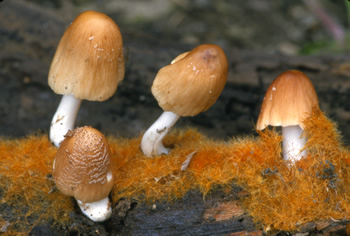Coprinellus radians
Scientific name: Coprinellus radians (Desm.) Vilgalys,
Hopple & Jacq. Johnson
Derivation of name: Copr- means "dung" and ellus is
diminutive. Radians means either 1) with rays or
spokes or 2) radiant.
Synonyms: Coprinus radians (Desm.) Fr.
Common name(s): Orange-mat coprinus
Phylum: Basidiomycota
Order: Agaricales
Family: Psathyrellaceae
Occurrence on wood substrate: Saprobic; single or scattered
or in small groups on wet wood; May through October.
Dimensions: Caps 2-3 cm wide; stipes 2.5-7.5 cm tall and
1.5-5
mm thick.
Cap: Tawny-brown to yellowish-orange; covered with
evanescent, brownish mealy particles.
Gills: Attached or almost free; white, becoming black and
liquefying (inky)
Spore print: Black.
Stipe: White, fragile, hollow and arising from a mat of yellow-
orange mycelium on top of the wood.
Veil: Universal veil breaking up as mealy particles (scales) on
the cap.
Comments: This species is found not only outdoors on wet
and rotting wood but also indoors on wet wood in basements
and bathrooms. Sometimes the orange mycelium is found
without the fruitbody. This species used to be in the genus
Coprinus but
DNA studies
radically revised the taxonomy
of that genus: Coprinus was retained for a small number of
species, several new genera were created, and the
members of the
family Coprinaceae were split between
two families - Psathyrellaceae and Agaricaceae.

Figure 1. Note the distinctive orange mat of mycelium.
Photo © John Plischke III.